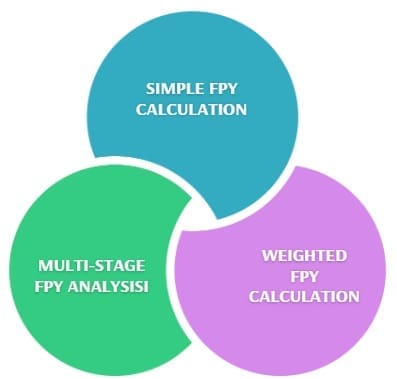First Time Yield (FTY), also known as First Pass Yield (FPY), represents one of the most critical quality metrics in modern manufacturing operations. This essential performance indicator measures the percentage of products that successfully pass through a manufacturing process without requiring rework, repair, or rejection during their initial production run.
Understanding what is First Time Yield becomes crucial for manufacturers seeking to optimize their operations and achieve lean manufacturing excellence. The concept directly impacts production costs, customer satisfaction, and overall operational efficiency, making it an indispensable tool for quality management professionals.
First Time Yield meaning extends beyond simple pass-fail ratios, encompassing the entire philosophy of getting things right the first time. This approach eliminates waste, reduces costs, and accelerates delivery times while maintaining superior product quality standards.
Table of contents
What is First Time Yield (FTY)?
First Time Yield (FTY), also known as First Pass Yield (FPY), is a critical quality metric in manufacturing and process industries. It measures the percentage of products or units that pass through a process step correctly on the first attempt, without needing any rework, repair, or correction
- FTY meaning: The proportion of defect-free units produced the first time, reflecting process effectiveness and efficiency.
- FPY meaning in manufacturing: Synonymous with FTY, it indicates how well a process produces quality output without rework.
Public, Onsite, Virtual, and Online Six Sigma Certification Training!
- We are accredited by the IASSC.
- Live Public Training at 52 Sites.
- Live Virtual Training.
- Onsite Training (at your organization).
- Interactive Online (self-paced) training,
First Time Yield vs. Rolled Throughput Yield (RTY)
| Metric | Definition | Considers Rework? | Best For |
| First Time Yield (FTY) | % of units passing a step the first time, no rework | No | Individual process step analysis |
| Rolled Throughput Yield (RTY) | % of units passing through all steps without rework (cumulative yield) | Yes | End-to-end process effectiveness |
What Does FPY Mean?
FPY meaning in manufacturing contexts refers to the fundamental metric that quantifies production efficiency at each process step. When professionals ask “what is FPY,” they’re seeking to understand how effectively their manufacturing processes create defect-free products during initial production attempts.
The First Pass Yield definition encompasses several key characteristics:
- Measures initial production success rates
- Excludes reworked or repaired items from success calculations
- Provides immediate feedback on process effectiveness
- Enables rapid identification of quality issues
FTY vs FPY
While FTY meaning and FPY meaning often appear interchangeably, both terms describe the same fundamental concept. First Time Through manufacturing represents the ideal scenario where products complete production without requiring additional processing steps or corrections.
Manufacturing professionals commonly use variations like 1st pass yield, first pass yeild (despite the misspelling), and first yield pass to reference this critical metric. Regardless of terminology preferences, the underlying principle remains consistent: measuring initial production success rates.
Basic First Pass Yield Formula
The fundamental First Pass Yield formula provides a straightforward calculation method:
FPY = (Number of Units Passed on First Attempt / Total Number of Units Processed) × 100
This FPY formula delivers immediate insights into process performance, enabling manufacturers to identify improvement opportunities quickly.
Also Read: What is Weighted Shortest Job First?
Advanced FPY Calculation Methods

How to calculate First Pass Yield effectively requires understanding various calculation approaches:
Simple FPY Calculation:
- Count total units entering the process
- Count units passing without rework
- Apply the basic formula above
Weighted FPY Calculation:
- Consider different defect severity levels
- Apply weightings based on rework complexity
- Calculate adjusted FPY scores
Multi-Stage FPY Analysis:
- Calculate FPY for individual process steps
- Combine results for overall process assessment
- Identify specific bottleneck areas
First Pass Yield Calculator Implementation
Creating an effective First Pass Yield calculator involves systematic data collection and analysis. Modern manufacturing systems integrate automated tracking capabilities, enabling real-time FPY monitoring and reporting.
FPY calculation accuracy depends on precise data collection, including:
- Accurate unit counting mechanisms
- Clear pass/fail criteria definitions
- Consistent measurement procedures
- Regular calibration activities
Production Yield Fundamentals
Yield in manufacturing encompasses multiple measurement approaches, with First Time Yield representing just one crucial component. Production yield analysis helps manufacturers understand overall equipment effectiveness and process capabilities.
Yield in production contexts considers several factors:
- Raw material utilization rates
- Process efficiency measurements
- Quality control effectiveness
- Equipment performance metrics
FPY Manufacturing Applications
FPY manufacturing implementations span diverse industries and production environments:
Electronics Manufacturing: Circuit board assembly, component placement, testing procedures Automotive Production: Engine assembly, painting processes, final inspection Pharmaceutical Manufacturing: Tablet production, packaging operations, quality testing Food Processing: Packaging lines, cooking processes, contamination control
First Pass Quality Integration
First Pass Quality initiatives combine FPY measurements with comprehensive quality management systems. This approach ensures that high yield rates accompany superior product quality standards.
Successful integration requires:
- Robust quality control procedures
- Employee training programs
- Statistical process control implementation
- Continuous improvement methodologies
Also Read: What is Average?
Advanced FPY Analysis and Benchmarking
What is a Good First Pass Yield Percentage?
What is a good First Pass Yield percentage depends significantly on industry standards, process complexity, and customer requirements. However, general benchmarks provide useful guidance:
Excellent Performance: 95-99% FPY Good Performance: 85-95% FPY Acceptable Performance: 75-85% FPY Needs Improvement: Below 75% FPY
These benchmarks vary considerably across industries, with some high-precision manufacturing environments requiring FPY rates exceeding 99.5% for acceptable performance.
First Pass Yield Examples
First Pass Yield example scenarios demonstrate practical applications:
Example 1: Electronics Assembly
- 1,000 circuit boards enter assembly process
- 920 boards pass initial testing
- FPY = (920/1,000) × 100 = 92%
Example 2: Automotive Paint Shop
- 500 car bodies enter painting process
- 475 achieve acceptable finish quality
- FPY = (475/500) × 100 = 95%
First Pass Yield Chart Analysis
First Pass Yield chart visualizations enable trend analysis and performance monitoring. Effective charts display:
- Time-series FPY data
- Process step comparisons
- Shift-to-shift variations
- Long-term improvement trends
Rolled Throughput Yield vs First Pass Yield
Understanding RTY Concepts
Rolled Throughput Yield (RTY) considers what factors beyond simple first-pass success rates. RTY calculations multiply individual process step FPY values to determine overall process yield rates.
Formula implementation:
RTY = FPY₁ × FPY₂ × FPY₃ × … × FPYₙ
How to Calculate RTY?
How to calculate RTY involves systematic analysis of multi-step processes:
- Identify all process steps
- Calculate individual FPY for each step
- Multiply all FPY values together
- Convert result to percentage
Rolled Throughput Yield vs First Pass Yield comparisons reveal different insights:
- RTY shows cumulative process impact
- FPY focuses on individual step performance
- RTY typically produces lower values than individual FPY measurements
Lean Manufacturing and Six Sigma Integration
Lean Metrics and FPY
What lean metric considers both scrap and rework in the entire process? First Time Yield serves as this comprehensive metric, capturing both types of waste simultaneously.
Lean manufacturing principles emphasize:
- Waste elimination through improved FPY
- Value stream optimization
- Continuous flow enhancement
- Customer value maximization
Also See: Best Lean Six Sigma Training in Minneapolis
Six Sigma and First Time Yield
First Time Six represents the ultimate quality goal, achieving 99.9997% defect-free production. While few processes achieve true Six Sigma performance, FPY measurements provide essential feedback for continuous improvement initiatives.
Six Sigma methodologies utilize FPY data for:
- Process capability analysis
- Control chart development
- Statistical process control
- Root cause analysis
Customer-Experienced Yield
What is the type of yield that is experienced by the customer?
Customers experience the final product quality, which reflects cumulative manufacturing effectiveness rather than individual process step performance.
Customer-focused yield considerations include:
- Final product functionality
- Aesthetic quality standards
- Reliability expectations
- Performance specifications
First Pass Rate Optimization
First Pass Rate improvement requires systematic approaches:
Process Analysis: Identify root causes of failures Equipment Maintenance: Ensure optimal machine performance Training Programs: Enhance operator capabilities Quality Systems: Implement robust control procedures.
Implementation Strategies and Best Practices
Data Collection Systems
Effective FPY monitoring requires robust data collection infrastructure:
- Automated tracking systems
- Real-time reporting capabilities
- Statistical analysis tools
- Trend monitoring dashboards
Continuous Improvement Integration
FPY improvement initiatives benefit from structured methodologies:
- Plan-Do-Check-Act (PDCA) cycles
- Kaizen events and workshops
- Root cause analysis techniques
- Statistical process control
Technology Integration
Modern manufacturing systems integrate FPY monitoring with:
- Enterprise Resource Planning (ERP) systems
- Manufacturing Execution Systems (MES)
- Quality Management Systems (QMS)
- Industrial Internet of Things (IIoT) platforms
Common Challenges and Solutions
Data Accuracy Issues
Maintaining accurate FPY calculations requires addressing:
- Inconsistent measurement criteria
- Manual data entry errors
- System integration challenges
- Real-time tracking limitations
Process Variability Management
FPY improvement efforts must consider:
- Material quality variations
- Equipment performance fluctuations
- Environmental condition changes
- Operator skill differences
Frequently Asked Questions (FAQ)
What is the difference between First Time Yield and Overall Equipment Effectiveness (OEE)?
First Time Yield focuses specifically on quality outcomes, measuring products that pass without rework, while OEE combines availability, performance, and quality metrics for comprehensive equipment evaluation.
How often should First Pass Yield be measured and reported?
FPY should be measured continuously during production and reported at least daily, with real-time monitoring preferred for critical processes to enable immediate corrective actions.
Can First Time Yield be applied to service industries?
Yes, FPY concepts apply to service processes by measuring transactions, requests, or deliverables that meet requirements without requiring rework or correction.
What factors most commonly cause low First Pass Yield rates?
Common causes include inadequate process control, insufficient operator training, poor equipment maintenance, defective raw materials, and unclear quality specifications.
How does First Time Yield relate to cost reduction in manufacturing?
Higher FPY directly reduces costs by eliminating rework labor, scrap material waste, additional inspection requirements, and delivery delays while improving customer satisfaction.
What software tools are recommended for FPY tracking and analysis?
Popular tools include statistical software like Minitab, manufacturing execution systems (MES), quality management platforms, and specialized FPY tracking applications integrated with production systems.



















